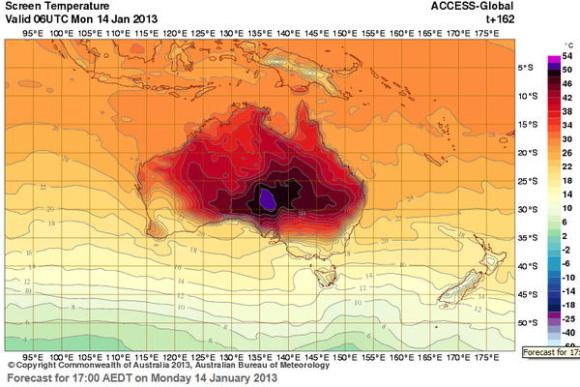Temperatures off the charts in Australia – Bureau of Meteorology adds new colors to represent record temperatures above 50°C (122°F)
By Peter Hannam, Carbon economy editor
9 January 2013 (Sydney Morning Herald) – Australia’s “dome of heat” has become so intense that the temperatures are rising off the charts – literally. The Bureau of Meteorology’s interactive weather forecasting chart has added new colours – deep purple and pink – to extend its previous temperature range that had been capped at 50 degrees. The range now extends to 54 degrees – well above the all-time record temperature of 50.7 degrees reached on January 2, 1960 at Oodnadatta Airport in South Australia – and, perhaps worryingly, the forecast outlook is starting to deploy the new colours. “The scale has just been increased today and I would anticipate it is because the forecast coming from the bureau’s model is showing temperatures in excess of 50 degrees,” David Jones, head of the bureau’s climate monitoring and prediction unit, said. While recent days have seen Australian temperature maps displaying maximums ranging from 40 degrees to 48 degrees – depicted in the colour scheme as burnt orange to black – both Sunday and Monday are now showing regions likely to hit 50 degrees or more, coloured purple. Clicking on the prediction for 5pm AEDT next Monday, a Tasmania-sized deep purple opens up over South Australia – implying 50 degrees or above. […] “The air mass over the inland is still heating up – it hasn’t peaked,” Dr Jones said. Australia’s first six days of 2013 were all among the hottest 20 days on record in terms of average maximums, with January 7 and today likely to add to the list of peaks. That would make it four of the top 10 in a little over a week. And the country has set a new national average maximum of 40.33 degrees on Monday, beating the previous record – set on December 21, 1972 – by a “sizeable margin” of 0.16 degrees, Dr Jones said, adding that the figures are preliminary. “Today is actually shaping up to be hotter – and it could be a record by a similar margin,” he said. [more]
